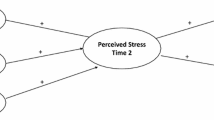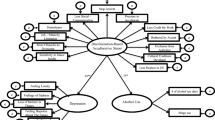Abstract
This study examined associations of immigrant generation, acculturation, and sources of stress and resilience with four outcomes—depression symptoms, anxiety symptoms, alcohol susceptibility, and smoking susceptibility. We used data from 1466 youth (ages 8–16) enrolled in the Hispanic Community Health Study of Latino Youth (SOL Youth), a probability sample of Hispanic/Latino youth living in Chicago (IL), Miami (FL), Bronx (NY), and San Diego (CA). We found no evidence of an immigrant paradox. Greater children’s acculturative stress was associated with depression/anxiety symptoms; greater parent’s acculturative stress was associated with smoking susceptibility. Family functioning and children’s ethnic identity were associated with fewer depression/anxiety symptoms and lower alcohol/smoking susceptibility. Although acculturation-related stressors increase youths’ risks for poor mental health and substance use, the development of positive ethnic identities and close, well-functioning family support systems can help protect Latino/Hispanic children from the negative behavioral and health-related consequences of stress.
Similar content being viewed by others
References
Kann L, McManus T, Harris WA, et al. Youth risk behavior surveillance–United States, 2015. MMWR Surveill Summ. 2016;65(6):1–50
Perreira KM, Ornelas IJ. The physical and psychological well-being of immigrant children. Future Child. 2011;21(1):195–218.
Alegría M, Canino G, Shrout PE, et al. Prevalence of mental illness in immigrant and non-immigrant US Latino groups. Am J Psychiatry. 2008;165(3):359–69.
Rudmin F. Constructs, measurements and models of acculturation and acculturative stress. Int J Intercult Relat. 2009;33(2):106–23.
Schwartz SJ, Unger JB, Zamboanga BL, Szapocznik J. Rethinking the concept of acculturation: implications for theory and research. Am Psychol. 2010;65(4):237–51.
Phinney JS, Horenczyk G, Liebkind K, Vedder P. Ethnic identity, immigration, and well-being: an interactional perspective. J Soc Issues. 2001;57(3):493–510.
Li K, Wen M. Substance use, age at migration, and length of residence among adult immigrants in the United States. J Immigr Minor Health. 2015;17(1):156–64.
Kopak AM. The relative importance of immigrant generation for Mexican Americans’ alcohol and tobacco use from adolescence to early adulthood. J Immigr Minor Health. 2013;15(3):569–76.
Lavange LM, Kalsbeek WD, Sorlie PD, et al. Sample design and cohort selection in the Hispanic Community Health Study/Study of Latinos. Ann Epidemiol. 2010;20(8):642–9.
Sorlie PD, Aviles-Santa LM, Wassertheil-Smoller S, et al. Design and implementation of the Hispanic Community Health Study/Study of Latinos. Ann Epidemiol. 2010;20(8):629–41.
Ayala GX, Carnethon MR, Arredondo E, et al. Theoretical foundations of the Study of Latino (SOL) Youth: implications for obesity and cardiometabolic risk. Ann Epidemiol. 2014;24(1):36–43.
Isasi CR, Carnethon MR, Ayala GX, et al. The Hispanic Community Children’s Health Study/Study of Latino Youth (SOL Youth): design, objectives, and procedures. Ann Epidemiol. 2014;24(1):29–35.
Davanzo P, Kerwin L, Nikore V, et al. Spanish translation and reliability testing of the child depression inventory. Child Psychiatry Hum Dev. 2004;35(1):75–92.
Kovacs M. The children’s depression, inventory (CDI). Psychopharmacol Bull. 1984;21(4):995–8.
March JS, Parker JD, Sullivan K, et al. The Multidimensional anxiety scale for children (MASC): factor structure, reliability, and validity. J Am Acad Child Adolesc Psychiatry. 1997;36(4):554–65.
Brooks-Russell A, Farhat T, Haynie D, Simons-Morton B. Trends in substance use among 6th-to 10th-grade students from 1998 to 2010: findings from a national probability study. J Early Adolesc. 2014;2015; 34(5):667–80.
Elder JP, Campbell NR, Litrownik AJ, Ayala GX, Slymen DJ, Parra-Medina D, Lovato CY. Predictors of cigarette and alcohol susceptibility and use among Hispanic migrant adolescents. Prev Med. 2000 31(2):115–123.
Pierce JP, Choi WS, Gilpin EA, et al. Validation of susceptibility as a predictor of which adolescents take up smoking in the United States. Health Psychol. 1996;15(5):355–61.
Unger JB, Gallaher P, Shakib S, et al. The AHIMSA acculturation scale: a new measure of acculturation for adolescents in a multicultural society. J Early Adolesc. 2002;22(3):225–51.
Gil AG, Wagner EF, Vega WA. Acculturation, familism, and alcohol use among Latino adolescent males: Longitudinal relations. J Community Psychol. 2000;28(4):443–58.
Harris KM. The National Longitudinal Study of Adolescent to Adult Health (Add Health), Waves I & II, 1994–1996; Wave III. 2001–2002; Wave IV, 2007–2009 [machine-readable data file and documentation]. Chapel Hill, NC: Carolina Population Center, University of North Carolina at Chapel Hill. https://doi.org/10.3886/ICPSR27021.v9.
Oropesa RS. Neighborhood disorder and social cohesiveness among immigrants in a new destination Dominicans in Reading, PA. Urban Stud. 2012;49(1):115–32.
Roberts RE, Phinney JS, Masse LC, et al. The structure of ethnic identity of young adolescents from diverse ethnocultural groups. J Early Adolesc. 1999;1999;19(3):301–22.
Sellers RM, Smith MA, Shelton JN, et al. Multidimensional model of racial identity: a reconceptualization of African American racial identity. Personal Soc Psychol Rev. 1998;2(1):18–39.
Byles J, Byrne C, Boyle MH, Offord DR. Ontario Child Health Study: reliability and validity of the general functioning subscale of the McMaster family assessment device. Fam Process. 1988;27(1):97–104.
Zimet GD, Powell SS, Farley GK, et al. Psychometric characteristics of the multidimensional scale of perceived social support. J Personal Assess. 1990;55:610–617.
Jackson C, Henriksen L, Foshee VA. The Authoritative Parenting Index: predicting health risk behaviors among children and adolescents. Health Educ Behav. 1998;25(3):319–37.
Steidel AGL, Contreras JM. A new familism scale for use with Latino populations. Hispanic J Behav Sci. 2003;25(3):312–30.
Bui HN. Racial and ethnic differences in the immigrant paradox in substance use. J Immigr Minor Health. 2013;15(5):866–81.
Prado G, Huang S, Schwartz SJ, et al. What accounts for differences in substance use among US-born and immigrant Hispanic adolescents? Results from a longitudinal prospective cohort study. J Adol Health. 2009;45(2):118–25.
Harker K. Immigrant generation, assimilation, and adolescent psychological well-being. Soc Forces. 2001;79(3):969–1004.
Potochnick SR, Perreira KM. Depression and anxiety among first-generation immigrant Latino youth: key correlates and implications for future research. J Nerv Ment Dis. 2010;198(7):470–7.
Stanton-Salazar RD. Manufacturing hope and despair: the school and kin support networks of US-Mexican youth. New York :Teachers College Press; 2001.
Landale NS, Hardie JH, Oropesa RS, Hillemeier MM. Behavioral functioning among Mexican-origin children does parental legal status matter? J Health Social Behavior. 2015;56(1):2–18.
Shonkoff JP, Garner AS, Siegel BS, et al. The lifelong effects of early childhood adversity and toxic stress. Pediatrics. 2012;129(1):e232–e246.
Funding
Funding was provided by National Heart, Lung, and Blood Institute (Grant Nos. R01HL102130, N01-HC65233, N01-HC65234, N01-HC65237, N01-HC65235 and N01-HC65236) and National Institute of Child Health and Human Development (Grant No. P2C HD50924).
Author information
Authors and Affiliations
Corresponding author
Ethics declarations
Conflict of interest
The authors declare no conflicts of interest.
Informed Consent
Informed consent was obtained from all individual participants included in this study.
Rights and permissions
About this article
Cite this article
Perreira, K.M., Marchante, A.N., Schwartz, S.J. et al. Stress and Resilience: Key Correlates of Mental Health and Substance Use in the Hispanic Community Health Study of Latino Youth. J Immigrant Minority Health 21, 4–13 (2019). https://doi.org/10.1007/s10903-018-0724-7
Published:
Issue Date:
DOI: https://doi.org/10.1007/s10903-018-0724-7




